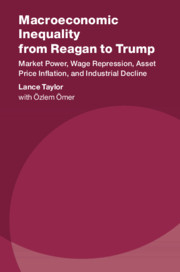 Macroeconomic Inequality from Reagan to Trump
Macroeconomic Inequality from Reagan to Trump Published online by Cambridge University Press: 31 July 2020
Capital theory is a small, recondite branch of economics but it can erupt into furious debate about the control of income and wealth. US distributive conflict has brought ancient academic battles to the fore. Capital theory helps shed light on the numbers but it will take some effort to grasp the details. One way to analyze distribution is in terms of the size of households’ incomes or holdings of wealth. Alternatively, macroeconomic growth and capital theories analyze the nature or function of payments flows, assets, and liabilities.
To save this book to your Kindle, first ensure [email protected] is added to your Approved Personal Document E-mail List under your Personal Document Settings on the Manage Your Content and Devices page of your Amazon account. Then enter the ‘name’ part of your Kindle email address below. Find out more about saving to your Kindle.
Note you can select to save to either the @free.kindle.com or @kindle.com variations. ‘@free.kindle.com’ emails are free but can only be saved to your device when it is connected to wi-fi. ‘@kindle.com’ emails can be delivered even when you are not connected to wi-fi, but note that service fees apply.
Find out more about the Kindle Personal Document Service.
To save content items to your account, please confirm that you agree to abide by our usage policies. If this is the first time you use this feature, you will be asked to authorise Cambridge Core to connect with your account. Find out more about saving content to Dropbox.
To save content items to your account, please confirm that you agree to abide by our usage policies. If this is the first time you use this feature, you will be asked to authorise Cambridge Core to connect with your account. Find out more about saving content to Google Drive.